Friday, March 8, 2024
Mar 8 (Fri) – I’m Trying Something Different
This post is a long runner. It’s for my coffee compadres.
 This story is about an F-4E Phantom that took some damage during the Vietnam War. F-4E tail # 321 was part of the 366th Tactical Fighter Wing located in West Thailand.
This story is about an F-4E Phantom that took some damage during the Vietnam War. F-4E tail # 321 was part of the 366th Tactical Fighter Wing located in West Thailand..
.
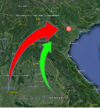 It’s mission that day was to fly in a package of sixteen F-4Es that would support a F-4E strike package from Ubon RTAFB in East Thailand. They would fly north, cross northern Laos, then turn east across North Vietnam towards Hanoi, then over “Downtown” Hanoi.
It’s mission that day was to fly in a package of sixteen F-4Es that would support a F-4E strike package from Ubon RTAFB in East Thailand. They would fly north, cross northern Laos, then turn east across North Vietnam towards Hanoi, then over “Downtown” Hanoi..
They would lay down a chaff corridor for the main strike package from Ubon which would be flying 20 minutes behind them. Their target was the Gia Lam Air Base Communication Control Buildings which housed the main communication system for the North Vietnamese Air Force.
.
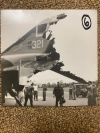 321’s pilot (Lt. Zimmerman) and Weapons System Officer in the back seat (Lt. Craighead) were good friends, having flown many missions together. On this mission their call sign was Clive 4. Element Lead’s call sign was Clive 3.
321’s pilot (Lt. Zimmerman) and Weapons System Officer in the back seat (Lt. Craighead) were good friends, having flown many missions together. On this mission their call sign was Clive 4. Element Lead’s call sign was Clive 3..
While flying east towards Hanoi the chaff force was notified by Red Crown (ground control) that MiGs were getting airborne in preparation for their arrival. 60 miles west of Hanoi the chaff force began receiving heavy AAA barrages from radar-controlled 85mm and 100mm cannons. As they crossed the Red River and continued east above Hanoi’s outlying flat lands the chaff force was targeted by SAM missiles. Of the many SAMs fired at the chaff force, one exploded just off the right wingtip of Clive 4. Zimmerman and Craighead saw only minor damage to the right aileron and with no caution lights they decided to continue their mission.
.
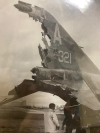 The chaff force concluded their inbound course and performed a group 180-degree turn to a westerly heading in order to exit the area. Shortly thereafter, Clive 3 made a radio call to Clive 4 “Break right, MiGs attacking!” A break turn is a maximum performance turn in order to negate an immediate attack from an adversary aircraft. In this instance, Clive 3 had spotted Clive 4 being attacked by a couple of MiG-19s with 30mm cannons blazing away. In fact, some 30mm rounds hit Clive 4’s vertical stabilizer.
The chaff force concluded their inbound course and performed a group 180-degree turn to a westerly heading in order to exit the area. Shortly thereafter, Clive 3 made a radio call to Clive 4 “Break right, MiGs attacking!” A break turn is a maximum performance turn in order to negate an immediate attack from an adversary aircraft. In this instance, Clive 3 had spotted Clive 4 being attacked by a couple of MiG-19s with 30mm cannons blazing away. In fact, some 30mm rounds hit Clive 4’s vertical stabilizer..
Clive 4 completed the 360 break turn and were again flying west on their exit heading. But they were now separated from the balance of the chaff force. They had lost visual contact with Clive 3. Shortly thereafter, a MiG-21 snuck into Clive 4’s six-o’clock position and fired his two heat-seeking Atoll missiles at the tailpipes of Clive 4. Both missiles scored a hit on the tail section resulting in heavy damage. They were now two young Lieutenants flying over the Hanoi area in a heavily-crippled F-4E. Many of their gauges were inoperative. Their navigation gear and radios were inoperative. The engines continued to run but with reduced capability. The cockpit intercom was OK so they were able to talk to each other.
.
 There was no panic in the cockpit as they agreed to turn to the southwest in order to overfly the least-populated areas of North Vietnam and Laos, so upon a probable ejection they would have a better chance of not being captured.
There was no panic in the cockpit as they agreed to turn to the southwest in order to overfly the least-populated areas of North Vietnam and Laos, so upon a probable ejection they would have a better chance of not being captured..
As they turned to the southwest they saw something interesting. About 1,500 feet off their left wing was the MiG-21 that had just shot his missiles at them. His cannons were apparently empty and having shot both of his Atoll missiles he was “Winchester” (out of weapons). He stayed there, flying in formation with Clive 4 for quite a while, possibly wondering how the F-4 was still airborne and to call in their location if they ejected.
.
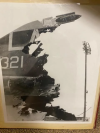 Clive 4 eventually saw the smoke trail of an F-4 in the distance, straight ahead of them and closing fast. The MiG pilot suddenly became aware of the inbound F-4 either by visual contact or by their ground controllers and made a sharp 180-degree turn back to the safety of Hanoi. It was flight lead Clive 3 that had returned for Clive 4. Clive 3 joined up with Clive 4 and through hand signals Clive 4 learned that Clive 3 would lead them to an air base in Northern Thailand called NKP. Although not home to F-4s, NKP would serve them well if they made it that far.
Clive 4 eventually saw the smoke trail of an F-4 in the distance, straight ahead of them and closing fast. The MiG pilot suddenly became aware of the inbound F-4 either by visual contact or by their ground controllers and made a sharp 180-degree turn back to the safety of Hanoi. It was flight lead Clive 3 that had returned for Clive 4. Clive 3 joined up with Clive 4 and through hand signals Clive 4 learned that Clive 3 would lead them to an air base in Northern Thailand called NKP. Although not home to F-4s, NKP would serve them well if they made it that far..
Zimmerman and Craighead prepared for possible ejection by stowing maps and other gear into the zippered pockets of their flight suits.
.
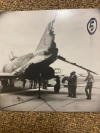 As they approached NKP, Clive 3 pulled ahead to land first for two reasons. First, he was very low on fuel. Second, Clive 4 could very well shut down the runway depending on how it landed. After all, it was missing most of its tail and had a damaged right aileron. NKP had launched a Jolly Green rescue helicopter which Clive 4 saw perched off their 2-o’clock. As they approached the NKP runway Clive 4 got caught up in the jet wash from Clive 3. Zimmerman decided to make a wide 360 turn in order to attempt a long straight-in approach in clean air.
As they approached NKP, Clive 3 pulled ahead to land first for two reasons. First, he was very low on fuel. Second, Clive 4 could very well shut down the runway depending on how it landed. After all, it was missing most of its tail and had a damaged right aileron. NKP had launched a Jolly Green rescue helicopter which Clive 4 saw perched off their 2-o’clock. As they approached the NKP runway Clive 4 got caught up in the jet wash from Clive 3. Zimmerman decided to make a wide 360 turn in order to attempt a long straight-in approach in clean air..
.
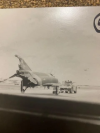 Clive 4’s utility hydraulic system had zero pressure so Zimmerman had to use the emergency blow-down system (pressurized air) to try to ‘blow down’ the landing gear. The cockpit gear indication showed ‘three green’ indicating all gear was down and locked. Good. Zimmerman’s next problem was not knowing what airspeed would be necessary to safely land the jet. He decided on a barrier engagement. He lowered the F-4’s tail hook and would land so as to engage the barrier cable stretched across the approach-end of the runway.
Clive 4’s utility hydraulic system had zero pressure so Zimmerman had to use the emergency blow-down system (pressurized air) to try to ‘blow down’ the landing gear. The cockpit gear indication showed ‘three green’ indicating all gear was down and locked. Good. Zimmerman’s next problem was not knowing what airspeed would be necessary to safely land the jet. He decided on a barrier engagement. He lowered the F-4’s tail hook and would land so as to engage the barrier cable stretched across the approach-end of the runway..
.
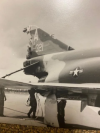 In the back seat, Lt Craighead noticed two things on final approach. Zimmerman had the control stick all the way to the right and their airspeed was 220 knots. This was much higher than the normal approach speed. Zimmerman flew a perfect approach. He touched down at 220 knots and the tail hook caught the cable. They quickly slowed to a gentle stop.
In the back seat, Lt Craighead noticed two things on final approach. Zimmerman had the control stick all the way to the right and their airspeed was 220 knots. This was much higher than the normal approach speed. Zimmerman flew a perfect approach. He touched down at 220 knots and the tail hook caught the cable. They quickly slowed to a gentle stop..
.
.
 As the hook released from the cable, the still-running engines rolled the jet into the grass just off the left edge of the runway where it soon came to a stop. Zimmerman and Craighead made swift exits from the cockpits, then finally got a look at the damage to their jet.
As the hook released from the cable, the still-running engines rolled the jet into the grass just off the left edge of the runway where it soon came to a stop. Zimmerman and Craighead made swift exits from the cockpits, then finally got a look at the damage to their jet..
Clive 3 gassed up and flew back to home station in West Thailand. Zimmerman and Craighead had only their flight suits and a few dollars between them. It took them three days to hitch-hike back to home station, first in a puddle-jumper to Utapao then another puddle-jumper to Takhli.
.
Aircraft 321 was repaired and continued to serve with distinction in three different squadrons. In the late 1970s, like so many other F-4s before her, she was converted to a remote-controlled full-size drone (a QF-4) that flew as a target for air-to-air practice over the training ranges in southern Nevada.